Case Study Report: Strategic Management of Apple Inc.
VerifiedAdded on 2024/04/29
|12
|4459
|385
AI Summary
This case study delves into Apple Inc.'s strategic management, including its competitive edge, market positioning, emergent strategies, SWOT analysis, PESTLE analysis, and organizational change.
Contribute Materials
Your contribution can guide someone’s learning journey. Share your
documents today.

Student number: STU200857
Module: Strategic Management
Case Study Report: APPLE INC
Date for Submission: 14.02.2024
Word count: 3886
Module: Strategic Management
Case Study Report: APPLE INC
Date for Submission: 14.02.2024
Word count: 3886
Secure Best Marks with AI Grader
Need help grading? Try our AI Grader for instant feedback on your assignments.
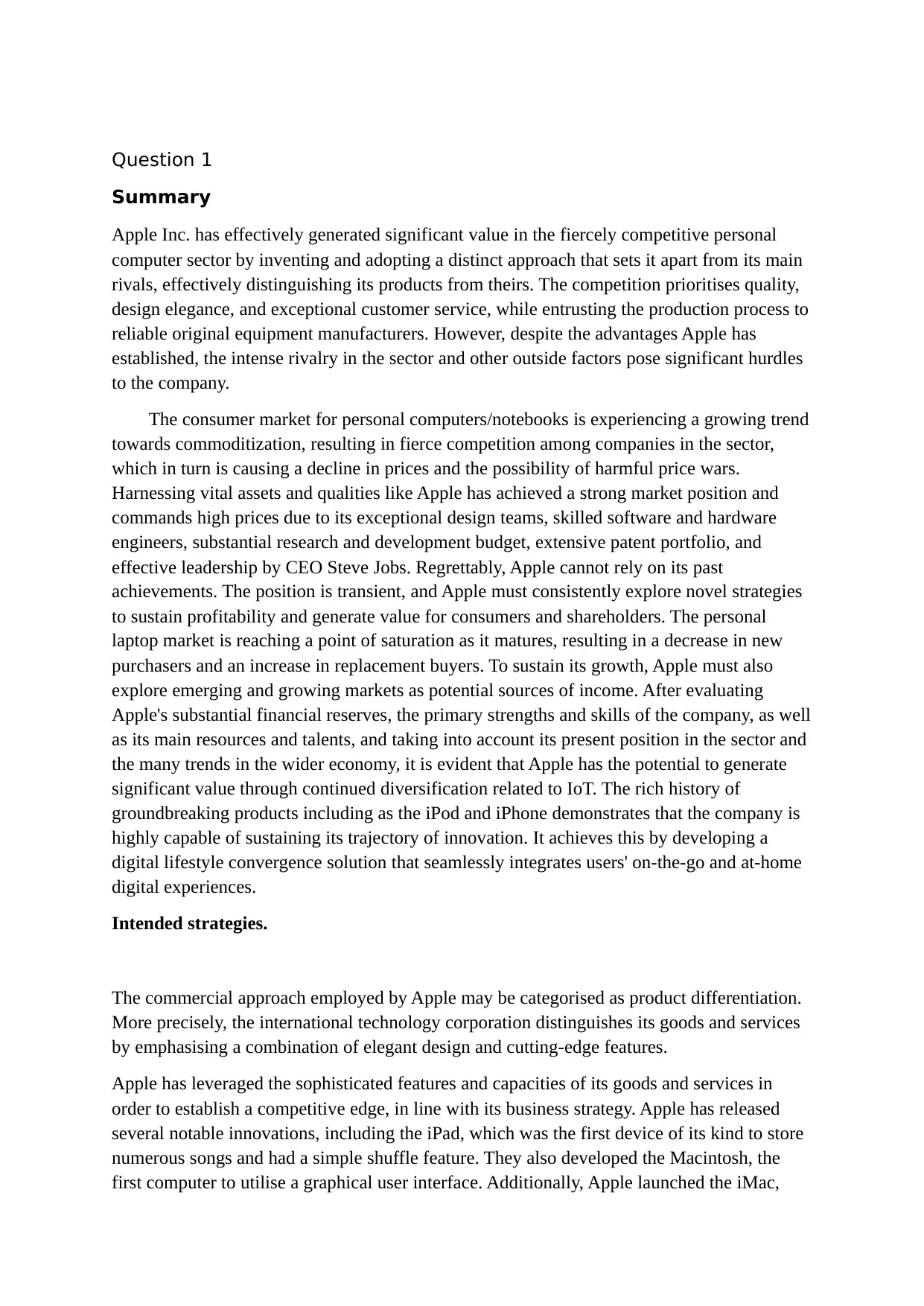
Question 1
Summary
Apple Inc. has effectively generated significant value in the fiercely competitive personal
computer sector by inventing and adopting a distinct approach that sets it apart from its main
rivals, effectively distinguishing its products from theirs. The competition prioritises quality,
design elegance, and exceptional customer service, while entrusting the production process to
reliable original equipment manufacturers. However, despite the advantages Apple has
established, the intense rivalry in the sector and other outside factors pose significant hurdles
to the company.
The consumer market for personal computers/notebooks is experiencing a growing trend
towards commoditization, resulting in fierce competition among companies in the sector,
which in turn is causing a decline in prices and the possibility of harmful price wars.
Harnessing vital assets and qualities like Apple has achieved a strong market position and
commands high prices due to its exceptional design teams, skilled software and hardware
engineers, substantial research and development budget, extensive patent portfolio, and
effective leadership by CEO Steve Jobs. Regrettably, Apple cannot rely on its past
achievements. The position is transient, and Apple must consistently explore novel strategies
to sustain profitability and generate value for consumers and shareholders. The personal
laptop market is reaching a point of saturation as it matures, resulting in a decrease in new
purchasers and an increase in replacement buyers. To sustain its growth, Apple must also
explore emerging and growing markets as potential sources of income. After evaluating
Apple's substantial financial reserves, the primary strengths and skills of the company, as well
as its main resources and talents, and taking into account its present position in the sector and
the many trends in the wider economy, it is evident that Apple has the potential to generate
significant value through continued diversification related to IoT. The rich history of
groundbreaking products including as the iPod and iPhone demonstrates that the company is
highly capable of sustaining its trajectory of innovation. It achieves this by developing a
digital lifestyle convergence solution that seamlessly integrates users' on-the-go and at-home
digital experiences.
Intended strategies.
The commercial approach employed by Apple may be categorised as product differentiation.
More precisely, the international technology corporation distinguishes its goods and services
by emphasising a combination of elegant design and cutting-edge features.
Apple has leveraged the sophisticated features and capacities of its goods and services in
order to establish a competitive edge, in line with its business strategy. Apple has released
several notable innovations, including the iPad, which was the first device of its kind to store
numerous songs and had a simple shuffle feature. They also developed the Macintosh, the
first computer to utilise a graphical user interface. Additionally, Apple launched the iMac,
Summary
Apple Inc. has effectively generated significant value in the fiercely competitive personal
computer sector by inventing and adopting a distinct approach that sets it apart from its main
rivals, effectively distinguishing its products from theirs. The competition prioritises quality,
design elegance, and exceptional customer service, while entrusting the production process to
reliable original equipment manufacturers. However, despite the advantages Apple has
established, the intense rivalry in the sector and other outside factors pose significant hurdles
to the company.
The consumer market for personal computers/notebooks is experiencing a growing trend
towards commoditization, resulting in fierce competition among companies in the sector,
which in turn is causing a decline in prices and the possibility of harmful price wars.
Harnessing vital assets and qualities like Apple has achieved a strong market position and
commands high prices due to its exceptional design teams, skilled software and hardware
engineers, substantial research and development budget, extensive patent portfolio, and
effective leadership by CEO Steve Jobs. Regrettably, Apple cannot rely on its past
achievements. The position is transient, and Apple must consistently explore novel strategies
to sustain profitability and generate value for consumers and shareholders. The personal
laptop market is reaching a point of saturation as it matures, resulting in a decrease in new
purchasers and an increase in replacement buyers. To sustain its growth, Apple must also
explore emerging and growing markets as potential sources of income. After evaluating
Apple's substantial financial reserves, the primary strengths and skills of the company, as well
as its main resources and talents, and taking into account its present position in the sector and
the many trends in the wider economy, it is evident that Apple has the potential to generate
significant value through continued diversification related to IoT. The rich history of
groundbreaking products including as the iPod and iPhone demonstrates that the company is
highly capable of sustaining its trajectory of innovation. It achieves this by developing a
digital lifestyle convergence solution that seamlessly integrates users' on-the-go and at-home
digital experiences.
Intended strategies.
The commercial approach employed by Apple may be categorised as product differentiation.
More precisely, the international technology corporation distinguishes its goods and services
by emphasising a combination of elegant design and cutting-edge features.
Apple has leveraged the sophisticated features and capacities of its goods and services in
order to establish a competitive edge, in line with its business strategy. Apple has released
several notable innovations, including the iPad, which was the first device of its kind to store
numerous songs and had a simple shuffle feature. They also developed the Macintosh, the
first computer to utilise a graphical user interface. Additionally, Apple launched the iMac,
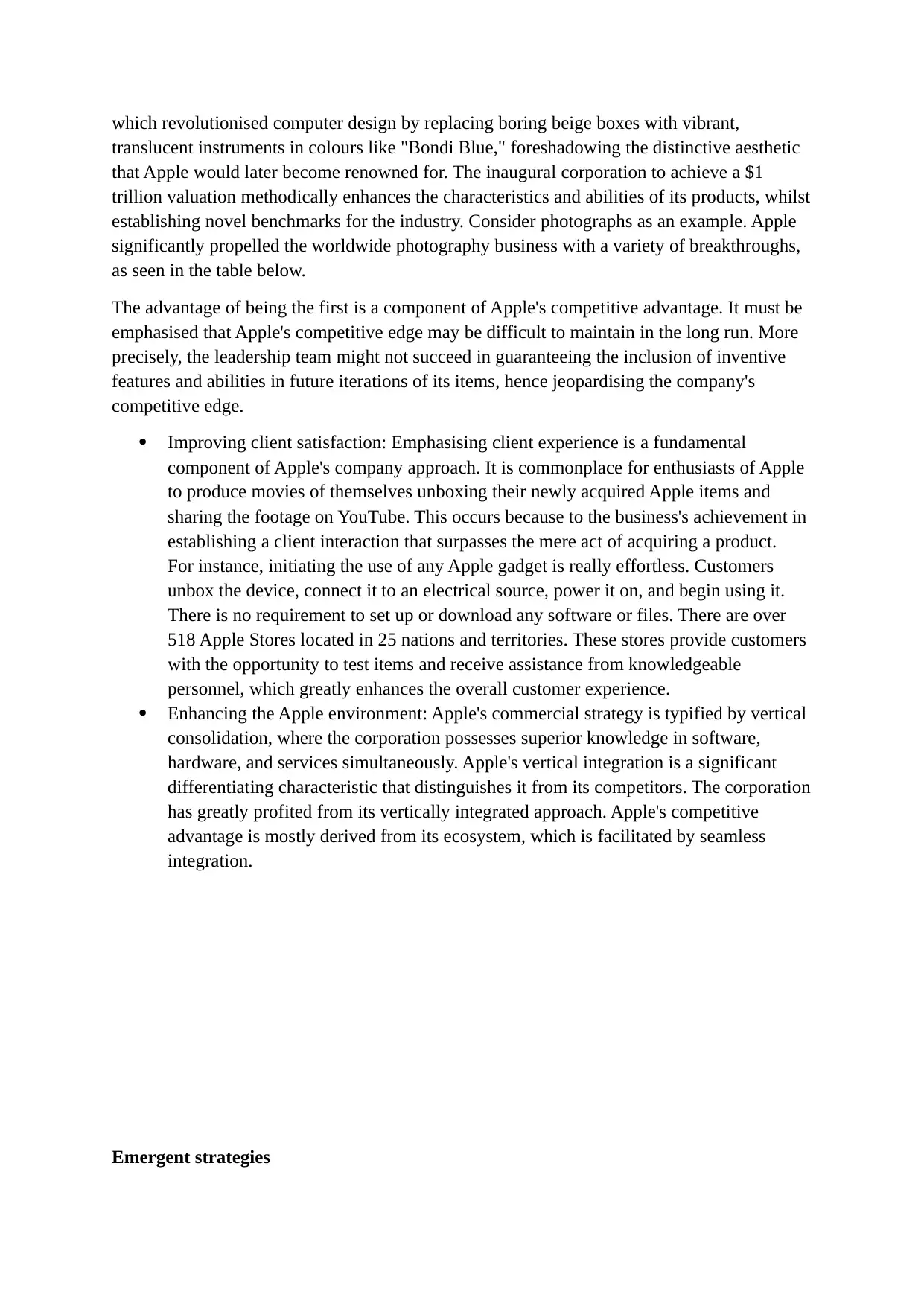
which revolutionised computer design by replacing boring beige boxes with vibrant,
translucent instruments in colours like "Bondi Blue," foreshadowing the distinctive aesthetic
that Apple would later become renowned for. The inaugural corporation to achieve a $1
trillion valuation methodically enhances the characteristics and abilities of its products, whilst
establishing novel benchmarks for the industry. Consider photographs as an example. Apple
significantly propelled the worldwide photography business with a variety of breakthroughs,
as seen in the table below.
The advantage of being the first is a component of Apple's competitive advantage. It must be
emphasised that Apple's competitive edge may be difficult to maintain in the long run. More
precisely, the leadership team might not succeed in guaranteeing the inclusion of inventive
features and abilities in future iterations of its items, hence jeopardising the company's
competitive edge.
Improving client satisfaction: Emphasising client experience is a fundamental
component of Apple's company approach. It is commonplace for enthusiasts of Apple
to produce movies of themselves unboxing their newly acquired Apple items and
sharing the footage on YouTube. This occurs because to the business's achievement in
establishing a client interaction that surpasses the mere act of acquiring a product.
For instance, initiating the use of any Apple gadget is really effortless. Customers
unbox the device, connect it to an electrical source, power it on, and begin using it.
There is no requirement to set up or download any software or files. There are over
518 Apple Stores located in 25 nations and territories. These stores provide customers
with the opportunity to test items and receive assistance from knowledgeable
personnel, which greatly enhances the overall customer experience.
Enhancing the Apple environment: Apple's commercial strategy is typified by vertical
consolidation, where the corporation possesses superior knowledge in software,
hardware, and services simultaneously. Apple's vertical integration is a significant
differentiating characteristic that distinguishes it from its competitors. The corporation
has greatly profited from its vertically integrated approach. Apple's competitive
advantage is mostly derived from its ecosystem, which is facilitated by seamless
integration.
Emergent strategies
translucent instruments in colours like "Bondi Blue," foreshadowing the distinctive aesthetic
that Apple would later become renowned for. The inaugural corporation to achieve a $1
trillion valuation methodically enhances the characteristics and abilities of its products, whilst
establishing novel benchmarks for the industry. Consider photographs as an example. Apple
significantly propelled the worldwide photography business with a variety of breakthroughs,
as seen in the table below.
The advantage of being the first is a component of Apple's competitive advantage. It must be
emphasised that Apple's competitive edge may be difficult to maintain in the long run. More
precisely, the leadership team might not succeed in guaranteeing the inclusion of inventive
features and abilities in future iterations of its items, hence jeopardising the company's
competitive edge.
Improving client satisfaction: Emphasising client experience is a fundamental
component of Apple's company approach. It is commonplace for enthusiasts of Apple
to produce movies of themselves unboxing their newly acquired Apple items and
sharing the footage on YouTube. This occurs because to the business's achievement in
establishing a client interaction that surpasses the mere act of acquiring a product.
For instance, initiating the use of any Apple gadget is really effortless. Customers
unbox the device, connect it to an electrical source, power it on, and begin using it.
There is no requirement to set up or download any software or files. There are over
518 Apple Stores located in 25 nations and territories. These stores provide customers
with the opportunity to test items and receive assistance from knowledgeable
personnel, which greatly enhances the overall customer experience.
Enhancing the Apple environment: Apple's commercial strategy is typified by vertical
consolidation, where the corporation possesses superior knowledge in software,
hardware, and services simultaneously. Apple's vertical integration is a significant
differentiating characteristic that distinguishes it from its competitors. The corporation
has greatly profited from its vertically integrated approach. Apple's competitive
advantage is mostly derived from its ecosystem, which is facilitated by seamless
integration.
Emergent strategies

Opacity around items: Apple divulges little details on the characteristics and information of
its new products. Consequently, individuals get enthusiastic about the good and cultivate a
sense of anticipation. This marketing approach employed by Apple is considered one of the
most effective.
Crafting an immersive encounter: Apple places great significance on customer experience
and holds it in high esteem. The company ensures that its customers enjoy a positive and
memorable purchasing experience. They ensure that every interaction point with customers,
including their physical and virtual shops, advertisements, and products, provides a
captivating and compelling experience for their clients.
Apple maintains a straightforward approach by ensuring simplicity in its marketing strategies
and product offerings. Their advertising use accessible language that is easily comprehensible
to the general populace. The product layouts and characteristics are uncomplicated and do not
inundate the clients. Although the language used is uncomplicated, they effectively
communicate the details of the items and how they contribute to streamlining your life.
Retaining clients: Rather than employing discounts to entice new consumers, Apple
prioritises the retention of its existing, loyal customers through the provision of exceptional
customer care. The client service promptly responds to customers who provide complaints
within a 24-hour timeframe.
The NPS index: Apple use the Net Promoter Score (NPS) as a metric to gauge the inclination
of consumers to endorse the firm's products and services. By implementing this approach,
salespersons refrain from engaging in up-selling or cross-selling with consumers who lack
interest in purchasing more items. This effectively mitigates the risk of customers departing
the stores with feelings of frustration and dissatisfaction.
What is Apple's tactical promotion plan?
Outlined below are many strategic initiatives that Apple implements to get a competitive
edge. Emphasise value: Apple directs their attention towards their Unique Value Proposition
(UVP). Apple demonstrates a willingness to determine the pricing of its products according to
their inherent worth, without fear. They promote the unique value proposition (UVP) of their
goods, highlighting how they enhance various elements of their consumers' life and provide a
specific price for them. Devoted patrons recognise the value and willingly accept the cost.
Attracting visuals: Apple employs really attractive pictures. Images facilitate the transmission
of a greater amount of information compared to words. The visual elements have a more
enduring influence on clients and are more easily remembered by them in relation to the
product.
Comprehending the objective market: The organisation possesses a deep understanding of its
clients' requirements and seamlessly integrates them into each of its novel offerings. Apple's
ability to satisfy client demands is crucial in maintaining its loyal customer base.
its new products. Consequently, individuals get enthusiastic about the good and cultivate a
sense of anticipation. This marketing approach employed by Apple is considered one of the
most effective.
Crafting an immersive encounter: Apple places great significance on customer experience
and holds it in high esteem. The company ensures that its customers enjoy a positive and
memorable purchasing experience. They ensure that every interaction point with customers,
including their physical and virtual shops, advertisements, and products, provides a
captivating and compelling experience for their clients.
Apple maintains a straightforward approach by ensuring simplicity in its marketing strategies
and product offerings. Their advertising use accessible language that is easily comprehensible
to the general populace. The product layouts and characteristics are uncomplicated and do not
inundate the clients. Although the language used is uncomplicated, they effectively
communicate the details of the items and how they contribute to streamlining your life.
Retaining clients: Rather than employing discounts to entice new consumers, Apple
prioritises the retention of its existing, loyal customers through the provision of exceptional
customer care. The client service promptly responds to customers who provide complaints
within a 24-hour timeframe.
The NPS index: Apple use the Net Promoter Score (NPS) as a metric to gauge the inclination
of consumers to endorse the firm's products and services. By implementing this approach,
salespersons refrain from engaging in up-selling or cross-selling with consumers who lack
interest in purchasing more items. This effectively mitigates the risk of customers departing
the stores with feelings of frustration and dissatisfaction.
What is Apple's tactical promotion plan?
Outlined below are many strategic initiatives that Apple implements to get a competitive
edge. Emphasise value: Apple directs their attention towards their Unique Value Proposition
(UVP). Apple demonstrates a willingness to determine the pricing of its products according to
their inherent worth, without fear. They promote the unique value proposition (UVP) of their
goods, highlighting how they enhance various elements of their consumers' life and provide a
specific price for them. Devoted patrons recognise the value and willingly accept the cost.
Attracting visuals: Apple employs really attractive pictures. Images facilitate the transmission
of a greater amount of information compared to words. The visual elements have a more
enduring influence on clients and are more easily remembered by them in relation to the
product.
Comprehending the objective market: The organisation possesses a deep understanding of its
clients' requirements and seamlessly integrates them into each of its novel offerings. Apple's
ability to satisfy client demands is crucial in maintaining its loyal customer base.
Secure Best Marks with AI Grader
Need help grading? Try our AI Grader for instant feedback on your assignments.
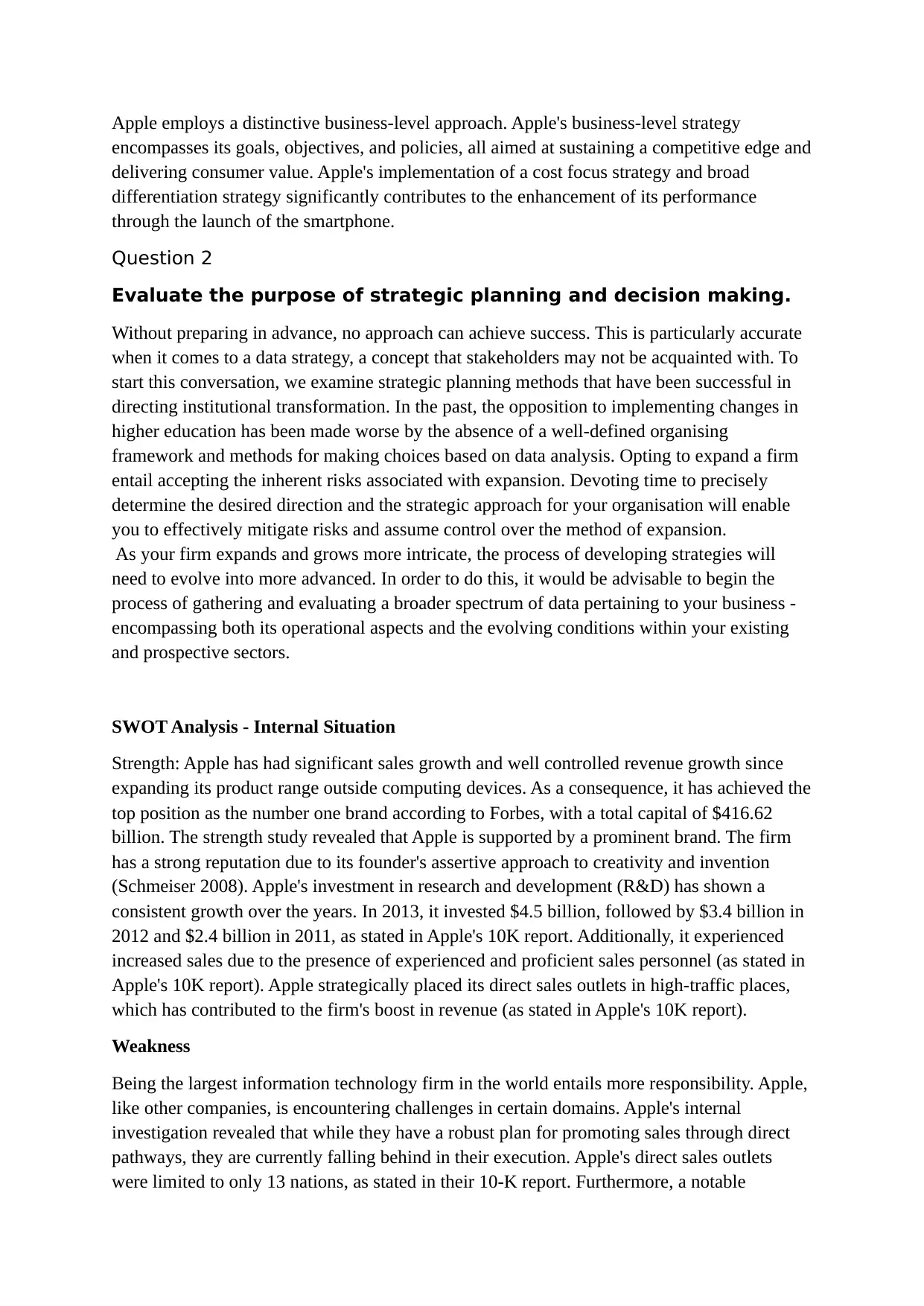
Apple employs a distinctive business-level approach. Apple's business-level strategy
encompasses its goals, objectives, and policies, all aimed at sustaining a competitive edge and
delivering consumer value. Apple's implementation of a cost focus strategy and broad
differentiation strategy significantly contributes to the enhancement of its performance
through the launch of the smartphone.
Question 2
Evaluate the purpose of strategic planning and decision making.
Without preparing in advance, no approach can achieve success. This is particularly accurate
when it comes to a data strategy, a concept that stakeholders may not be acquainted with. To
start this conversation, we examine strategic planning methods that have been successful in
directing institutional transformation. In the past, the opposition to implementing changes in
higher education has been made worse by the absence of a well-defined organising
framework and methods for making choices based on data analysis. Opting to expand a firm
entail accepting the inherent risks associated with expansion. Devoting time to precisely
determine the desired direction and the strategic approach for your organisation will enable
you to effectively mitigate risks and assume control over the method of expansion.
As your firm expands and grows more intricate, the process of developing strategies will
need to evolve into more advanced. In order to do this, it would be advisable to begin the
process of gathering and evaluating a broader spectrum of data pertaining to your business -
encompassing both its operational aspects and the evolving conditions within your existing
and prospective sectors.
SWOT Analysis - Internal Situation
Strength: Apple has had significant sales growth and well controlled revenue growth since
expanding its product range outside computing devices. As a consequence, it has achieved the
top position as the number one brand according to Forbes, with a total capital of $416.62
billion. The strength study revealed that Apple is supported by a prominent brand. The firm
has a strong reputation due to its founder's assertive approach to creativity and invention
(Schmeiser 2008). Apple's investment in research and development (R&D) has shown a
consistent growth over the years. In 2013, it invested $4.5 billion, followed by $3.4 billion in
2012 and $2.4 billion in 2011, as stated in Apple's 10K report. Additionally, it experienced
increased sales due to the presence of experienced and proficient sales personnel (as stated in
Apple's 10K report). Apple strategically placed its direct sales outlets in high-traffic places,
which has contributed to the firm's boost in revenue (as stated in Apple's 10K report).
Weakness
Being the largest information technology firm in the world entails more responsibility. Apple,
like other companies, is encountering challenges in certain domains. Apple's internal
investigation revealed that while they have a robust plan for promoting sales through direct
pathways, they are currently falling behind in their execution. Apple's direct sales outlets
were limited to only 13 nations, as stated in their 10-K report. Furthermore, a notable
encompasses its goals, objectives, and policies, all aimed at sustaining a competitive edge and
delivering consumer value. Apple's implementation of a cost focus strategy and broad
differentiation strategy significantly contributes to the enhancement of its performance
through the launch of the smartphone.
Question 2
Evaluate the purpose of strategic planning and decision making.
Without preparing in advance, no approach can achieve success. This is particularly accurate
when it comes to a data strategy, a concept that stakeholders may not be acquainted with. To
start this conversation, we examine strategic planning methods that have been successful in
directing institutional transformation. In the past, the opposition to implementing changes in
higher education has been made worse by the absence of a well-defined organising
framework and methods for making choices based on data analysis. Opting to expand a firm
entail accepting the inherent risks associated with expansion. Devoting time to precisely
determine the desired direction and the strategic approach for your organisation will enable
you to effectively mitigate risks and assume control over the method of expansion.
As your firm expands and grows more intricate, the process of developing strategies will
need to evolve into more advanced. In order to do this, it would be advisable to begin the
process of gathering and evaluating a broader spectrum of data pertaining to your business -
encompassing both its operational aspects and the evolving conditions within your existing
and prospective sectors.
SWOT Analysis - Internal Situation
Strength: Apple has had significant sales growth and well controlled revenue growth since
expanding its product range outside computing devices. As a consequence, it has achieved the
top position as the number one brand according to Forbes, with a total capital of $416.62
billion. The strength study revealed that Apple is supported by a prominent brand. The firm
has a strong reputation due to its founder's assertive approach to creativity and invention
(Schmeiser 2008). Apple's investment in research and development (R&D) has shown a
consistent growth over the years. In 2013, it invested $4.5 billion, followed by $3.4 billion in
2012 and $2.4 billion in 2011, as stated in Apple's 10K report. Additionally, it experienced
increased sales due to the presence of experienced and proficient sales personnel (as stated in
Apple's 10K report). Apple strategically placed its direct sales outlets in high-traffic places,
which has contributed to the firm's boost in revenue (as stated in Apple's 10K report).
Weakness
Being the largest information technology firm in the world entails more responsibility. Apple,
like other companies, is encountering challenges in certain domains. Apple's internal
investigation revealed that while they have a robust plan for promoting sales through direct
pathways, they are currently falling behind in their execution. Apple's direct sales outlets
were limited to only 13 nations, as stated in their 10-K report. Furthermore, a notable

vulnerability lies in Apple's reliance on the iPhone and iPod, as their impact on total sales is
predominant (Biddle 2014. In addition, the company's hardware items are exclusively
compatible with iOS, which poses challenges for users. In contrast, rivals' products are
compatible with the Android operating system, eliminating such complications. Research has
also shown that the products of this company are considered luxury items and come with a
higher price tag. The average individual would choose to allocate their funds towards more
economically advantageous investments rather than making a purchase (Nair, 2014). Apple
suffered a significant loss with the passing of its highly esteemed manager, Steve Jobs. There
is a significant shift in thought on the iPhone between Cook and Jobs.
Apple's losing market share is attributed to the lowering sales growth, which is a notable
issue for the company (Apple 10-K).
Opportunities
Apple Inc. has the chance to broaden its supply chain. This potential is linked to the
company's goods, such as tablets and cell phones, being distributed in a restricted manner.
Apple may enhance its worldwide appeal by establishing a more extensive distribution
system. Moreover, the firm has the potential to enhance its sales volumes by using assertive
marketing strategies, particularly for mobile devices. This possibility is correlated with a
significant need for mobile connectivity, as demonstrated in the examination of Apple Inc.
The expansion of product offerings facilitates corporate expansion, particularly in
competition with other technological companies in the global market. Therefore, this
particular component of Apple's SWOT analysis suggests that the company has significant
prospects for expansion while facing fierce rivalry.
Threats to Apple Inc. (Outside Influences)
The intense rivalry in the technology market can be attributed, in part, to the assertive
strategies employed by companies that prioritise fast innovation. As an illustration, in the
realm of commercial gadgets and internet services. Apple rivals with Google, amazon,
Samsung, Microsoft likewise compares with the video streaming facilities like Netflix,
Amazon Play. The presence of intense rivalry in the industry has a constraining impact on the
firm, highlighting the need for robust foundations to sustain competitive edge in computer
equipment and software, as well as internet services. Furthermore, Apple is confronted with
the peril of product copying, particularly with regards to the iPhone. Both local and global
companies can partially replicate the design and characteristics of Apple's goods. In addition,
the increasing labour expenses associated with contract workers, particularly those located in
China, result in decreased revenues, or further elevate selling prices.
Key spots in swot analysis
The internal and exterior elements outlined in this SWOT analysis suggest that Apple Inc. has
significant strengths that may be utilised to successfully fix any vulnerabilities within the
organisation. Apple may leverage these capabilities to take advantage of possibilities, such as
predominant (Biddle 2014. In addition, the company's hardware items are exclusively
compatible with iOS, which poses challenges for users. In contrast, rivals' products are
compatible with the Android operating system, eliminating such complications. Research has
also shown that the products of this company are considered luxury items and come with a
higher price tag. The average individual would choose to allocate their funds towards more
economically advantageous investments rather than making a purchase (Nair, 2014). Apple
suffered a significant loss with the passing of its highly esteemed manager, Steve Jobs. There
is a significant shift in thought on the iPhone between Cook and Jobs.
Apple's losing market share is attributed to the lowering sales growth, which is a notable
issue for the company (Apple 10-K).
Opportunities
Apple Inc. has the chance to broaden its supply chain. This potential is linked to the
company's goods, such as tablets and cell phones, being distributed in a restricted manner.
Apple may enhance its worldwide appeal by establishing a more extensive distribution
system. Moreover, the firm has the potential to enhance its sales volumes by using assertive
marketing strategies, particularly for mobile devices. This possibility is correlated with a
significant need for mobile connectivity, as demonstrated in the examination of Apple Inc.
The expansion of product offerings facilitates corporate expansion, particularly in
competition with other technological companies in the global market. Therefore, this
particular component of Apple's SWOT analysis suggests that the company has significant
prospects for expansion while facing fierce rivalry.
Threats to Apple Inc. (Outside Influences)
The intense rivalry in the technology market can be attributed, in part, to the assertive
strategies employed by companies that prioritise fast innovation. As an illustration, in the
realm of commercial gadgets and internet services. Apple rivals with Google, amazon,
Samsung, Microsoft likewise compares with the video streaming facilities like Netflix,
Amazon Play. The presence of intense rivalry in the industry has a constraining impact on the
firm, highlighting the need for robust foundations to sustain competitive edge in computer
equipment and software, as well as internet services. Furthermore, Apple is confronted with
the peril of product copying, particularly with regards to the iPhone. Both local and global
companies can partially replicate the design and characteristics of Apple's goods. In addition,
the increasing labour expenses associated with contract workers, particularly those located in
China, result in decreased revenues, or further elevate selling prices.
Key spots in swot analysis
The internal and exterior elements outlined in this SWOT analysis suggest that Apple Inc. has
significant strengths that may be utilised to successfully fix any vulnerabilities within the
organisation. Apple may leverage these capabilities to take advantage of possibilities, such as
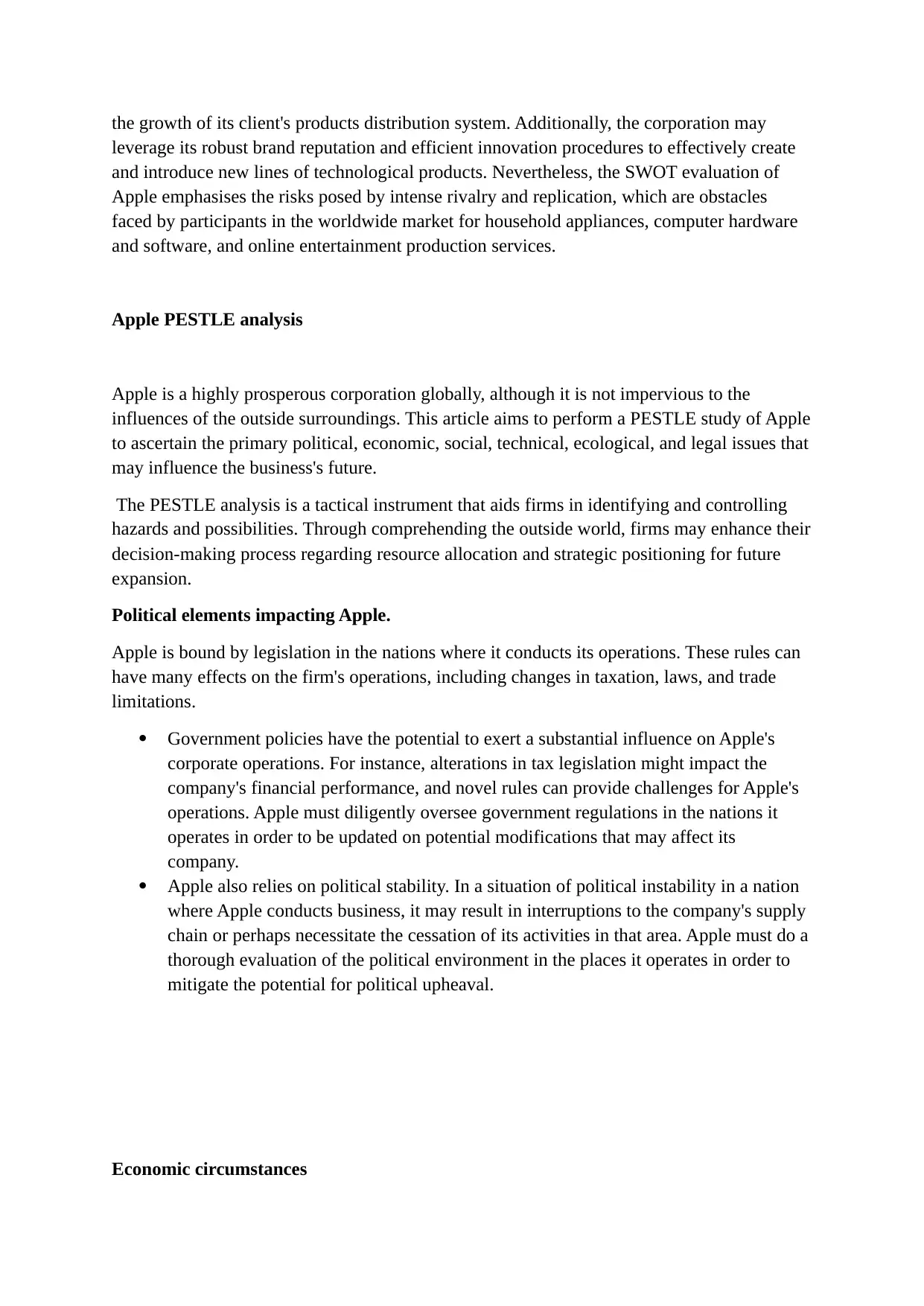
the growth of its client's products distribution system. Additionally, the corporation may
leverage its robust brand reputation and efficient innovation procedures to effectively create
and introduce new lines of technological products. Nevertheless, the SWOT evaluation of
Apple emphasises the risks posed by intense rivalry and replication, which are obstacles
faced by participants in the worldwide market for household appliances, computer hardware
and software, and online entertainment production services.
Apple PESTLE analysis
Apple is a highly prosperous corporation globally, although it is not impervious to the
influences of the outside surroundings. This article aims to perform a PESTLE study of Apple
to ascertain the primary political, economic, social, technical, ecological, and legal issues that
may influence the business's future.
The PESTLE analysis is a tactical instrument that aids firms in identifying and controlling
hazards and possibilities. Through comprehending the outside world, firms may enhance their
decision-making process regarding resource allocation and strategic positioning for future
expansion.
Political elements impacting Apple.
Apple is bound by legislation in the nations where it conducts its operations. These rules can
have many effects on the firm's operations, including changes in taxation, laws, and trade
limitations.
Government policies have the potential to exert a substantial influence on Apple's
corporate operations. For instance, alterations in tax legislation might impact the
company's financial performance, and novel rules can provide challenges for Apple's
operations. Apple must diligently oversee government regulations in the nations it
operates in order to be updated on potential modifications that may affect its
company.
Apple also relies on political stability. In a situation of political instability in a nation
where Apple conducts business, it may result in interruptions to the company's supply
chain or perhaps necessitate the cessation of its activities in that area. Apple must do a
thorough evaluation of the political environment in the places it operates in order to
mitigate the potential for political upheaval.
Economic circumstances
leverage its robust brand reputation and efficient innovation procedures to effectively create
and introduce new lines of technological products. Nevertheless, the SWOT evaluation of
Apple emphasises the risks posed by intense rivalry and replication, which are obstacles
faced by participants in the worldwide market for household appliances, computer hardware
and software, and online entertainment production services.
Apple PESTLE analysis
Apple is a highly prosperous corporation globally, although it is not impervious to the
influences of the outside surroundings. This article aims to perform a PESTLE study of Apple
to ascertain the primary political, economic, social, technical, ecological, and legal issues that
may influence the business's future.
The PESTLE analysis is a tactical instrument that aids firms in identifying and controlling
hazards and possibilities. Through comprehending the outside world, firms may enhance their
decision-making process regarding resource allocation and strategic positioning for future
expansion.
Political elements impacting Apple.
Apple is bound by legislation in the nations where it conducts its operations. These rules can
have many effects on the firm's operations, including changes in taxation, laws, and trade
limitations.
Government policies have the potential to exert a substantial influence on Apple's
corporate operations. For instance, alterations in tax legislation might impact the
company's financial performance, and novel rules can provide challenges for Apple's
operations. Apple must diligently oversee government regulations in the nations it
operates in order to be updated on potential modifications that may affect its
company.
Apple also relies on political stability. In a situation of political instability in a nation
where Apple conducts business, it may result in interruptions to the company's supply
chain or perhaps necessitate the cessation of its activities in that area. Apple must do a
thorough evaluation of the political environment in the places it operates in order to
mitigate the potential for political upheaval.
Economic circumstances
Paraphrase This Document
Need a fresh take? Get an instant paraphrase of this document with our AI Paraphraser
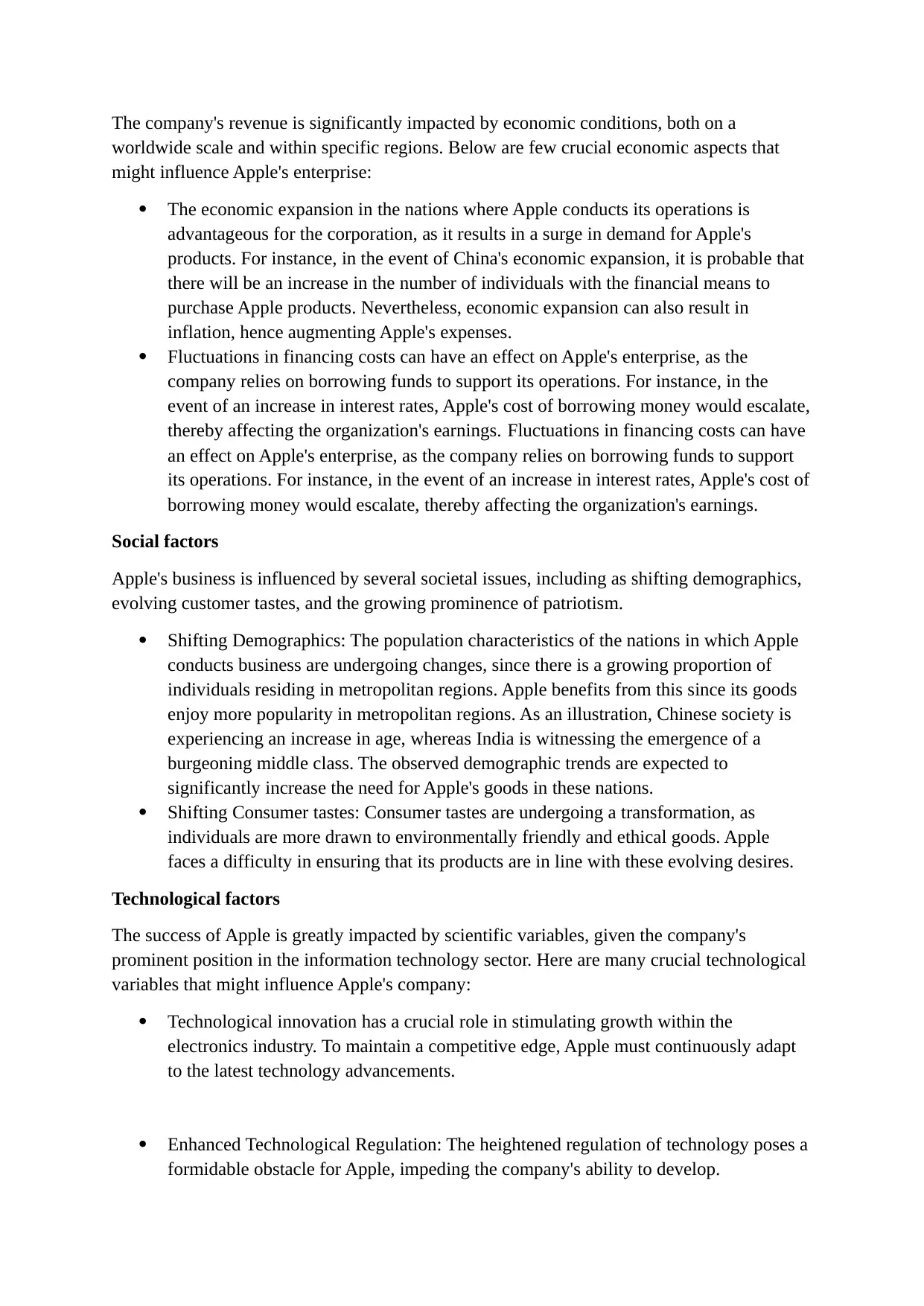
The company's revenue is significantly impacted by economic conditions, both on a
worldwide scale and within specific regions. Below are few crucial economic aspects that
might influence Apple's enterprise:
The economic expansion in the nations where Apple conducts its operations is
advantageous for the corporation, as it results in a surge in demand for Apple's
products. For instance, in the event of China's economic expansion, it is probable that
there will be an increase in the number of individuals with the financial means to
purchase Apple products. Nevertheless, economic expansion can also result in
inflation, hence augmenting Apple's expenses.
Fluctuations in financing costs can have an effect on Apple's enterprise, as the
company relies on borrowing funds to support its operations. For instance, in the
event of an increase in interest rates, Apple's cost of borrowing money would escalate,
thereby affecting the organization's earnings. Fluctuations in financing costs can have
an effect on Apple's enterprise, as the company relies on borrowing funds to support
its operations. For instance, in the event of an increase in interest rates, Apple's cost of
borrowing money would escalate, thereby affecting the organization's earnings.
Social factors
Apple's business is influenced by several societal issues, including as shifting demographics,
evolving customer tastes, and the growing prominence of patriotism.
Shifting Demographics: The population characteristics of the nations in which Apple
conducts business are undergoing changes, since there is a growing proportion of
individuals residing in metropolitan regions. Apple benefits from this since its goods
enjoy more popularity in metropolitan regions. As an illustration, Chinese society is
experiencing an increase in age, whereas India is witnessing the emergence of a
burgeoning middle class. The observed demographic trends are expected to
significantly increase the need for Apple's goods in these nations.
Shifting Consumer tastes: Consumer tastes are undergoing a transformation, as
individuals are more drawn to environmentally friendly and ethical goods. Apple
faces a difficulty in ensuring that its products are in line with these evolving desires.
Technological factors
The success of Apple is greatly impacted by scientific variables, given the company's
prominent position in the information technology sector. Here are many crucial technological
variables that might influence Apple's company:
Technological innovation has a crucial role in stimulating growth within the
electronics industry. To maintain a competitive edge, Apple must continuously adapt
to the latest technology advancements.
Enhanced Technological Regulation: The heightened regulation of technology poses a
formidable obstacle for Apple, impeding the company's ability to develop.
worldwide scale and within specific regions. Below are few crucial economic aspects that
might influence Apple's enterprise:
The economic expansion in the nations where Apple conducts its operations is
advantageous for the corporation, as it results in a surge in demand for Apple's
products. For instance, in the event of China's economic expansion, it is probable that
there will be an increase in the number of individuals with the financial means to
purchase Apple products. Nevertheless, economic expansion can also result in
inflation, hence augmenting Apple's expenses.
Fluctuations in financing costs can have an effect on Apple's enterprise, as the
company relies on borrowing funds to support its operations. For instance, in the
event of an increase in interest rates, Apple's cost of borrowing money would escalate,
thereby affecting the organization's earnings. Fluctuations in financing costs can have
an effect on Apple's enterprise, as the company relies on borrowing funds to support
its operations. For instance, in the event of an increase in interest rates, Apple's cost of
borrowing money would escalate, thereby affecting the organization's earnings.
Social factors
Apple's business is influenced by several societal issues, including as shifting demographics,
evolving customer tastes, and the growing prominence of patriotism.
Shifting Demographics: The population characteristics of the nations in which Apple
conducts business are undergoing changes, since there is a growing proportion of
individuals residing in metropolitan regions. Apple benefits from this since its goods
enjoy more popularity in metropolitan regions. As an illustration, Chinese society is
experiencing an increase in age, whereas India is witnessing the emergence of a
burgeoning middle class. The observed demographic trends are expected to
significantly increase the need for Apple's goods in these nations.
Shifting Consumer tastes: Consumer tastes are undergoing a transformation, as
individuals are more drawn to environmentally friendly and ethical goods. Apple
faces a difficulty in ensuring that its products are in line with these evolving desires.
Technological factors
The success of Apple is greatly impacted by scientific variables, given the company's
prominent position in the information technology sector. Here are many crucial technological
variables that might influence Apple's company:
Technological innovation has a crucial role in stimulating growth within the
electronics industry. To maintain a competitive edge, Apple must continuously adapt
to the latest technology advancements.
Enhanced Technological Regulation: The heightened regulation of technology poses a
formidable obstacle for Apple, impeding the company's ability to develop.
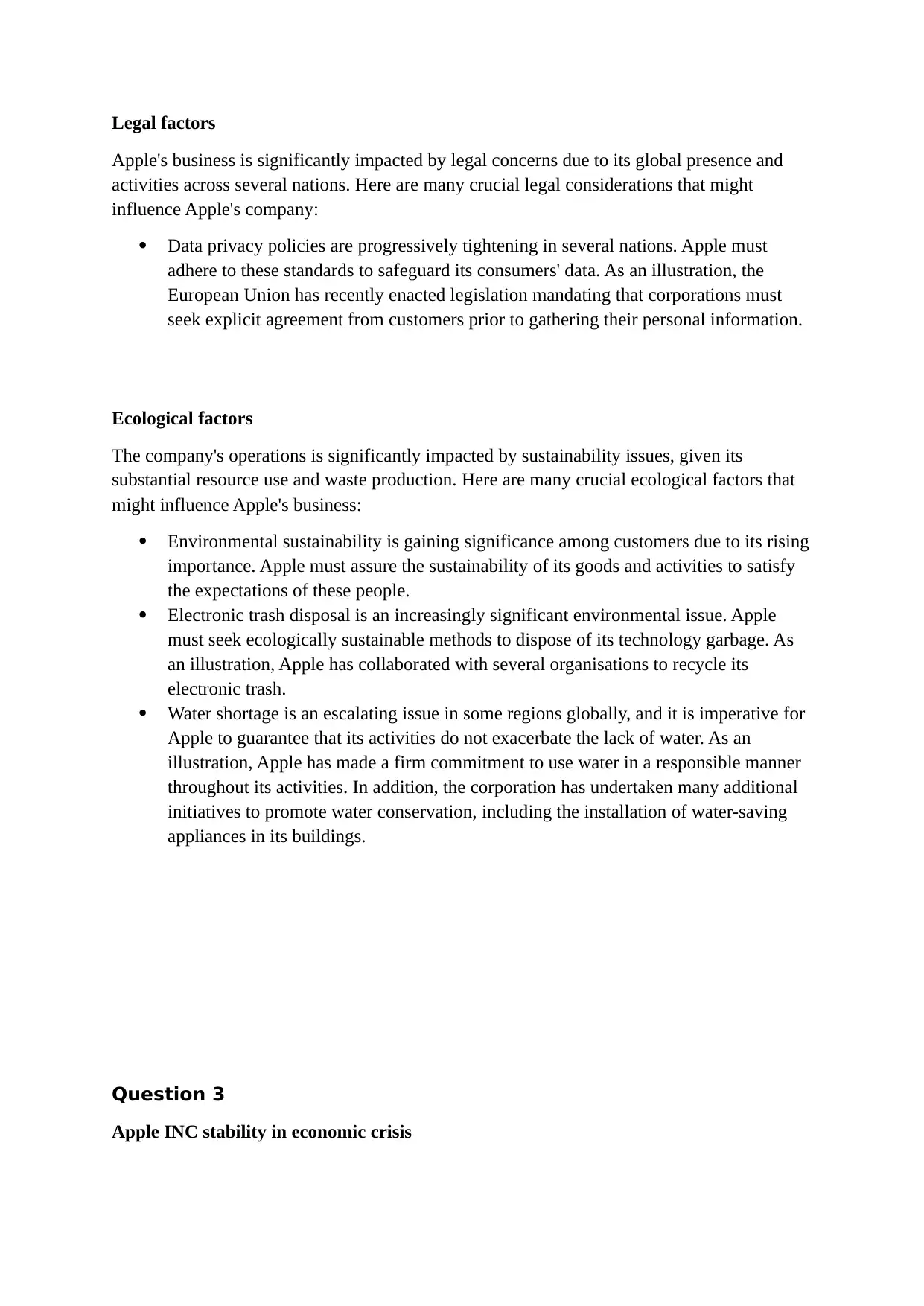
Legal factors
Apple's business is significantly impacted by legal concerns due to its global presence and
activities across several nations. Here are many crucial legal considerations that might
influence Apple's company:
Data privacy policies are progressively tightening in several nations. Apple must
adhere to these standards to safeguard its consumers' data. As an illustration, the
European Union has recently enacted legislation mandating that corporations must
seek explicit agreement from customers prior to gathering their personal information.
Ecological factors
The company's operations is significantly impacted by sustainability issues, given its
substantial resource use and waste production. Here are many crucial ecological factors that
might influence Apple's business:
Environmental sustainability is gaining significance among customers due to its rising
importance. Apple must assure the sustainability of its goods and activities to satisfy
the expectations of these people.
Electronic trash disposal is an increasingly significant environmental issue. Apple
must seek ecologically sustainable methods to dispose of its technology garbage. As
an illustration, Apple has collaborated with several organisations to recycle its
electronic trash.
Water shortage is an escalating issue in some regions globally, and it is imperative for
Apple to guarantee that its activities do not exacerbate the lack of water. As an
illustration, Apple has made a firm commitment to use water in a responsible manner
throughout its activities. In addition, the corporation has undertaken many additional
initiatives to promote water conservation, including the installation of water-saving
appliances in its buildings.
Question 3
Apple INC stability in economic crisis
Apple's business is significantly impacted by legal concerns due to its global presence and
activities across several nations. Here are many crucial legal considerations that might
influence Apple's company:
Data privacy policies are progressively tightening in several nations. Apple must
adhere to these standards to safeguard its consumers' data. As an illustration, the
European Union has recently enacted legislation mandating that corporations must
seek explicit agreement from customers prior to gathering their personal information.
Ecological factors
The company's operations is significantly impacted by sustainability issues, given its
substantial resource use and waste production. Here are many crucial ecological factors that
might influence Apple's business:
Environmental sustainability is gaining significance among customers due to its rising
importance. Apple must assure the sustainability of its goods and activities to satisfy
the expectations of these people.
Electronic trash disposal is an increasingly significant environmental issue. Apple
must seek ecologically sustainable methods to dispose of its technology garbage. As
an illustration, Apple has collaborated with several organisations to recycle its
electronic trash.
Water shortage is an escalating issue in some regions globally, and it is imperative for
Apple to guarantee that its activities do not exacerbate the lack of water. As an
illustration, Apple has made a firm commitment to use water in a responsible manner
throughout its activities. In addition, the corporation has undertaken many additional
initiatives to promote water conservation, including the installation of water-saving
appliances in its buildings.
Question 3
Apple INC stability in economic crisis

Due to the relatively higher affluence of Apple consumers compared to the ordinary
consumer, they possess greater financial capacity to sustain their expenditure on
technological items. Moreover, Apple's robust brand will provide significant support in
navigating a period of economic slump. Companies are compelled to manufacture products
in accordance with customer expectations. Companies must use novel techniques that
guarantee client satisfaction and offer competitive pricing (Mansoor, 2011). Apple has used
cost reduction measures in non-essential sectors. In the 2008/2009 financial year, the
corporation implemented a strategic reaction to the economic downturn by reducing its
operational expenses by 10%.
Nevertheless, the corporation has augmented its expenditure on the areas of operation
deemed crucial for the expansion of the company. These encompass advertising and scientific
advancement (R&D). The company's investment in research and development has facilitated
its ability to overcome the crisis by creating and producing innovative goods, such as the
iPad. The customers evaluated the iPad as possessing a high level of value, and this value
aligned with the price at which it was supplied. The company's premise is that investing in
scientific inquiry will lead to breakthroughs that will ultimately provide the organisation a
lasting competitive edge. The corporation also prioritised marketing and classified it
alongside research and development. The corporation contended that allocating resources to
marketing would guarantee a boost in output and an acceptable return on expenditures. The
corporation prioritised its marketing efforts towards brand creation and public relations
initiatives. Hewlett and Packard, however, employed a territorial strategy by means of
takeovers and purchases of lesser competitors. By engaging in client acquisition through
purchases, the corporation has successfully expanded its customer base while significantly
diminishing competition. Furthermore, the corporation has made significant investments in
brand development and other marketing methods.
Organizational change
Structural adjustment yields several benefits, including the ability to maintain a competitive
advantage and stay pertinent within your industry. Change fosters creativity, cultivates
talents, nurtures staff development, and paves the way for enhanced company prospects,
ultimately boosting worker morale. Apple employs a hierarchical organisational structure that
exhibits distinct divisional features and a rather ineffective functional matrix. The firm's
hierarchy is a conventional architectural characteristic in commercial organisations. The
divisional characteristics pertain to the categorization of Apple's products based on their
respective divisions, such as iOS and macOS. The weak operational matrix entails
communication across divisions while maintaining the company's hierarchical structure.
Spoke-and-Manoeuvre topology: consequently, the company's organisational structure
has become more flexible, while it still maintains a hierarchical arrangement with Tim
Cook as the central figure. The highest level (innermost level in the spoke-and-wheel
circle) of the corporate structure employs function-based classification, which is a
characteristic inherited from the operational type of organisational structure. Senior
consumer, they possess greater financial capacity to sustain their expenditure on
technological items. Moreover, Apple's robust brand will provide significant support in
navigating a period of economic slump. Companies are compelled to manufacture products
in accordance with customer expectations. Companies must use novel techniques that
guarantee client satisfaction and offer competitive pricing (Mansoor, 2011). Apple has used
cost reduction measures in non-essential sectors. In the 2008/2009 financial year, the
corporation implemented a strategic reaction to the economic downturn by reducing its
operational expenses by 10%.
Nevertheless, the corporation has augmented its expenditure on the areas of operation
deemed crucial for the expansion of the company. These encompass advertising and scientific
advancement (R&D). The company's investment in research and development has facilitated
its ability to overcome the crisis by creating and producing innovative goods, such as the
iPad. The customers evaluated the iPad as possessing a high level of value, and this value
aligned with the price at which it was supplied. The company's premise is that investing in
scientific inquiry will lead to breakthroughs that will ultimately provide the organisation a
lasting competitive edge. The corporation also prioritised marketing and classified it
alongside research and development. The corporation contended that allocating resources to
marketing would guarantee a boost in output and an acceptable return on expenditures. The
corporation prioritised its marketing efforts towards brand creation and public relations
initiatives. Hewlett and Packard, however, employed a territorial strategy by means of
takeovers and purchases of lesser competitors. By engaging in client acquisition through
purchases, the corporation has successfully expanded its customer base while significantly
diminishing competition. Furthermore, the corporation has made significant investments in
brand development and other marketing methods.
Organizational change
Structural adjustment yields several benefits, including the ability to maintain a competitive
advantage and stay pertinent within your industry. Change fosters creativity, cultivates
talents, nurtures staff development, and paves the way for enhanced company prospects,
ultimately boosting worker morale. Apple employs a hierarchical organisational structure that
exhibits distinct divisional features and a rather ineffective functional matrix. The firm's
hierarchy is a conventional architectural characteristic in commercial organisations. The
divisional characteristics pertain to the categorization of Apple's products based on their
respective divisions, such as iOS and macOS. The weak operational matrix entails
communication across divisions while maintaining the company's hierarchical structure.
Spoke-and-Manoeuvre topology: consequently, the company's organisational structure
has become more flexible, while it still maintains a hierarchical arrangement with Tim
Cook as the central figure. The highest level (innermost level in the spoke-and-wheel
circle) of the corporate structure employs function-based classification, which is a
characteristic inherited from the operational type of organisational structure. Senior
Secure Best Marks with AI Grader
Need help grading? Try our AI Grader for instant feedback on your assignments.
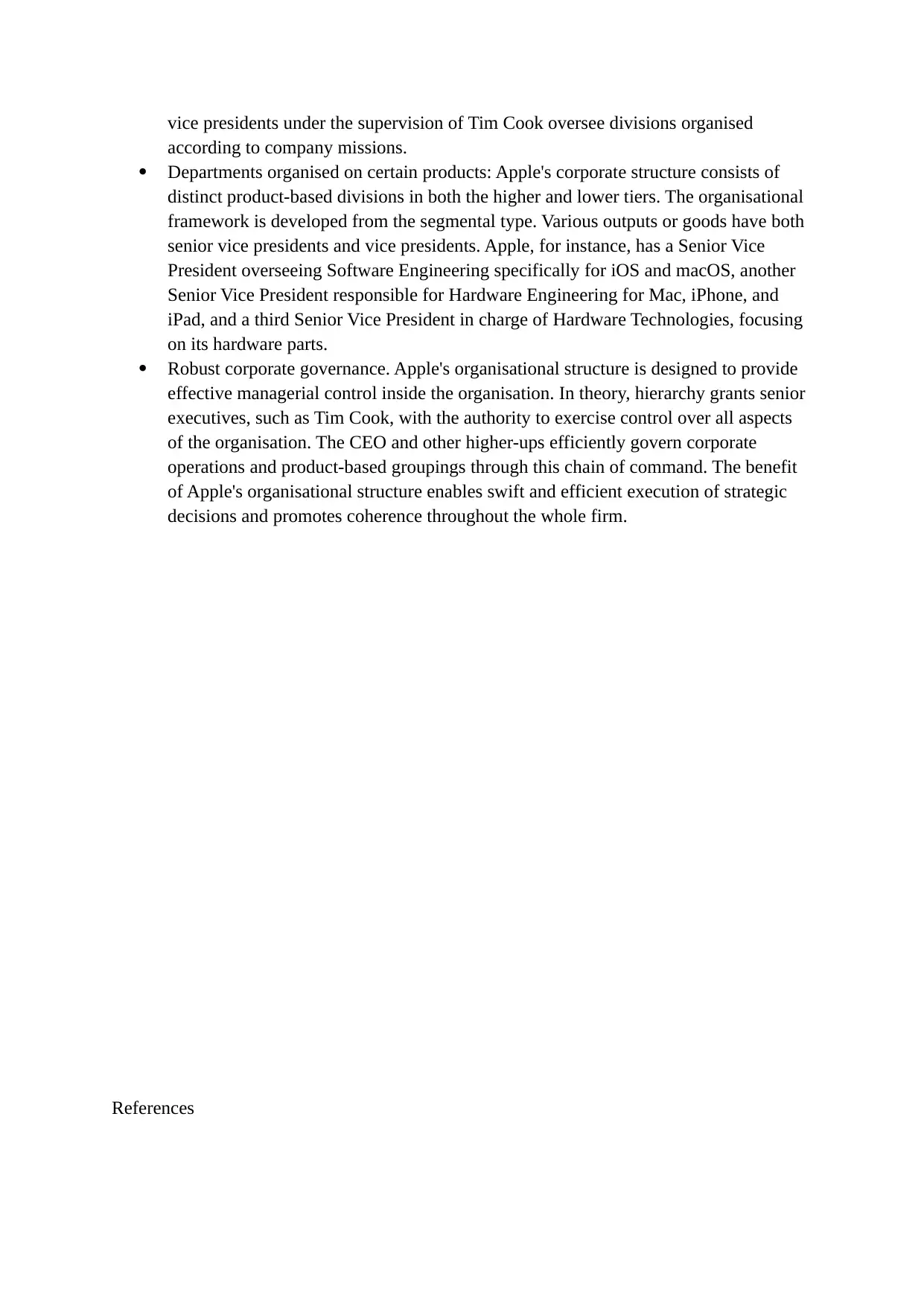
vice presidents under the supervision of Tim Cook oversee divisions organised
according to company missions.
Departments organised on certain products: Apple's corporate structure consists of
distinct product-based divisions in both the higher and lower tiers. The organisational
framework is developed from the segmental type. Various outputs or goods have both
senior vice presidents and vice presidents. Apple, for instance, has a Senior Vice
President overseeing Software Engineering specifically for iOS and macOS, another
Senior Vice President responsible for Hardware Engineering for Mac, iPhone, and
iPad, and a third Senior Vice President in charge of Hardware Technologies, focusing
on its hardware parts.
Robust corporate governance. Apple's organisational structure is designed to provide
effective managerial control inside the organisation. In theory, hierarchy grants senior
executives, such as Tim Cook, with the authority to exercise control over all aspects
of the organisation. The CEO and other higher-ups efficiently govern corporate
operations and product-based groupings through this chain of command. The benefit
of Apple's organisational structure enables swift and efficient execution of strategic
decisions and promotes coherence throughout the whole firm.
References
according to company missions.
Departments organised on certain products: Apple's corporate structure consists of
distinct product-based divisions in both the higher and lower tiers. The organisational
framework is developed from the segmental type. Various outputs or goods have both
senior vice presidents and vice presidents. Apple, for instance, has a Senior Vice
President overseeing Software Engineering specifically for iOS and macOS, another
Senior Vice President responsible for Hardware Engineering for Mac, iPhone, and
iPad, and a third Senior Vice President in charge of Hardware Technologies, focusing
on its hardware parts.
Robust corporate governance. Apple's organisational structure is designed to provide
effective managerial control inside the organisation. In theory, hierarchy grants senior
executives, such as Tim Cook, with the authority to exercise control over all aspects
of the organisation. The CEO and other higher-ups efficiently govern corporate
operations and product-based groupings through this chain of command. The benefit
of Apple's organisational structure enables swift and efficient execution of strategic
decisions and promotes coherence throughout the whole firm.
References
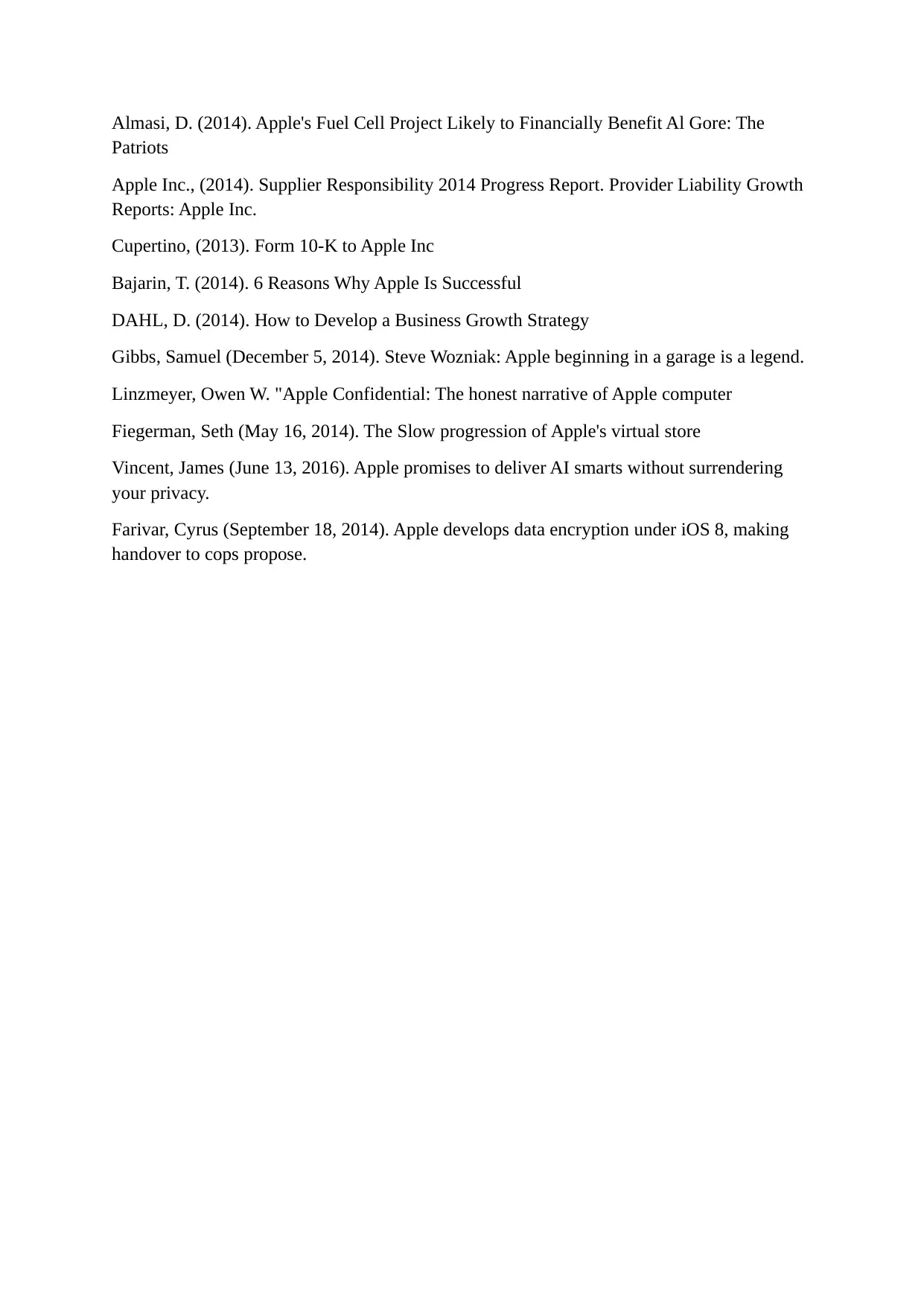
Almasi, D. (2014). Apple's Fuel Cell Project Likely to Financially Benefit Al Gore: The
Patriots
Apple Inc., (2014). Supplier Responsibility 2014 Progress Report. Provider Liability Growth
Reports: Apple Inc.
Cupertino, (2013). Form 10-K to Apple Inc
Bajarin, T. (2014). 6 Reasons Why Apple Is Successful
DAHL, D. (2014). How to Develop a Business Growth Strategy
Gibbs, Samuel (December 5, 2014). Steve Wozniak: Apple beginning in a garage is a legend.
Linzmeyer, Owen W. "Apple Confidential: The honest narrative of Apple computer
Fiegerman, Seth (May 16, 2014). The Slow progression of Apple's virtual store
Vincent, James (June 13, 2016). Apple promises to deliver AI smarts without surrendering
your privacy.
Farivar, Cyrus (September 18, 2014). Apple develops data encryption under iOS 8, making
handover to cops propose.
Patriots
Apple Inc., (2014). Supplier Responsibility 2014 Progress Report. Provider Liability Growth
Reports: Apple Inc.
Cupertino, (2013). Form 10-K to Apple Inc
Bajarin, T. (2014). 6 Reasons Why Apple Is Successful
DAHL, D. (2014). How to Develop a Business Growth Strategy
Gibbs, Samuel (December 5, 2014). Steve Wozniak: Apple beginning in a garage is a legend.
Linzmeyer, Owen W. "Apple Confidential: The honest narrative of Apple computer
Fiegerman, Seth (May 16, 2014). The Slow progression of Apple's virtual store
Vincent, James (June 13, 2016). Apple promises to deliver AI smarts without surrendering
your privacy.
Farivar, Cyrus (September 18, 2014). Apple develops data encryption under iOS 8, making
handover to cops propose.
1 out of 12
Related Documents
Your All-in-One AI-Powered Toolkit for Academic Success.
+13062052269
info@desklib.com
Available 24*7 on WhatsApp / Email
![[object Object]](/_next/static/media/star-bottom.7253800d.svg)
Unlock your academic potential
© 2024 | Zucol Services PVT LTD | All rights reserved.





